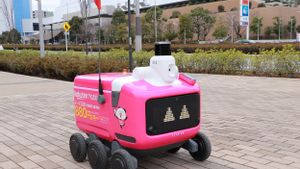YOGYAKARTA - Similar but not the same is the most appropriate term for describing autopilot and autonomous. While both trying to erode human control, autopilot is very different from autonomous. Can you explain the difference between the two? Below, we will try to explain the differences between autopilot and autonomous cars.
Autopilot is a technology that adopts the self-driving concept. Vehicles that use an autopilot system use high camera sensor specifications. The camera sensor will capture the objects around while you are reading on a fast-moving autopilot car.
No doubt, the camera sensor on the autopilot car is the same as your second eye. Once the vehicle is turned on, the driver can immediately activate self-driving mode and sit back at the wheel. Drivers are needed for small tasks such as turning on and off the vehicle, and when danger or emergency cannot be handled by the system.
Thus, the autopilot vehicle still needs the crew to control it. However, the crew does not continue to control the vehicle manually. Did you know that autopilot was adopted on an airplane and a self-driving car? The latest news is Tesla Motors which released an autopilot car in Indonesia, the Tesla X Model.
Autonomouss are different, autonomous, not having a crew at all. Vehicles with autonomous technology are developed completely unmanned. From the engine turned on to reaching its destination, autonomous vehicles do not require human control.
How does an autonomous vehicle work? If an autopilot vehicle uses a camera sensor, an autonomous vehicle works by receiving and capturing laser signals via LIDAR or Light Sense Radar. Unfortunately, until now the autonomous vehicle is still under development, so we can't see it yet. The technology itself faces several issues related to the safety of its passengers.
Cars that are fully autonomous can decide whether to enter the intersection safely. It can decide how to maneuver around other vehicles, people, and other moving objects. Autonomous cars, such as Google Self-Driving Cars, rely on detailed information about the roads they go through before entering the road.
Google cars generate 3D maps of the area with stationary objects, including traffic light identification, which are combined with existing high-resolution area maps to create data models they use to navigate. Understanding how other objects, including people and other cars, will behave and succeed in predicting what they will do is essential to achieve fully autonomous driving capabilities.
It makes sense to expect that technically we can get there, however, with the possibility of an unlimited scenario while driving, autonomous vehicles will never be perfect. Google's first self-driving car accident where the car's AV mode was wrong earlier this year, and the result was low speed spatbor support.
This is a bit funny and indicates the AV's apparently too careful nature because Google cars travel at a speed of 2 mph. when it collides with a bus traveling at a speed of 15 mp.h trying to re-enter traffic after realizing that the path is blocked by sandbags.
Conclusion
After knowing the difference between autopilot and autonomous, you must not be confused about the difference, right? Autopilot still needs a crew/driver, while autonomous is fully unmanned. Autopilot uses high camera sensor specifications, while autonomous uses LIDAR. Hopefully, this information helps you.
So after knowing the difference between autopilot and autonomous cars, watch other interesting news on VOI, it's time to revolutionize news!
The English, Chinese, Japanese, Arabic, and French versions are automatically generated by the AI. So there may still be inaccuracies in translating, please always see Indonesian as our main language. (system supported by DigitalSiber.id)













